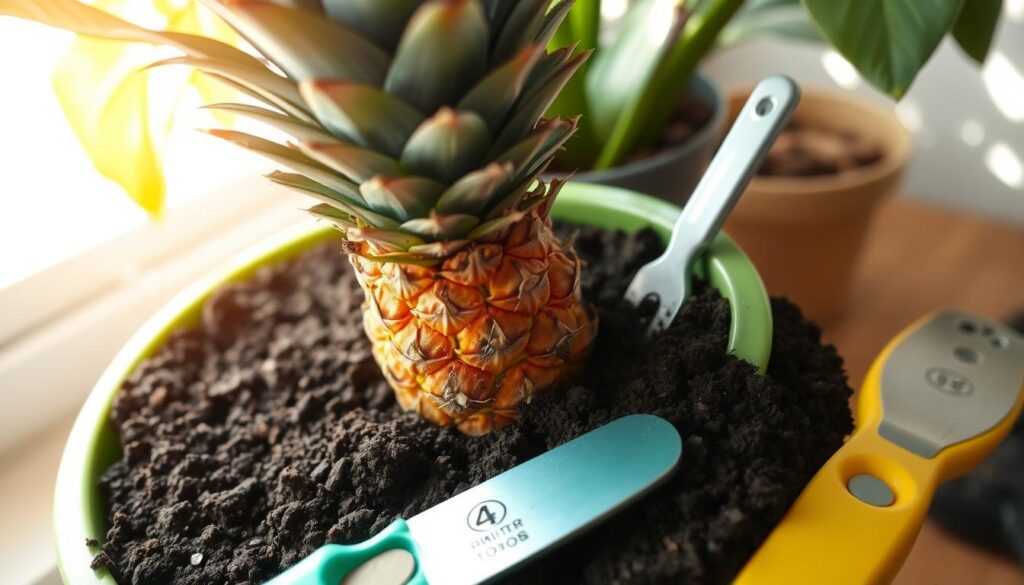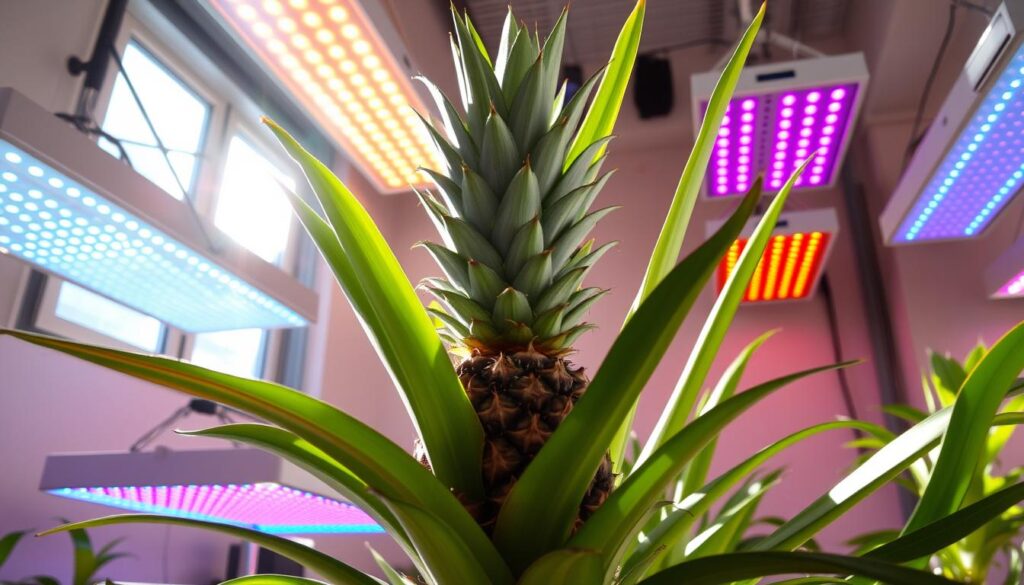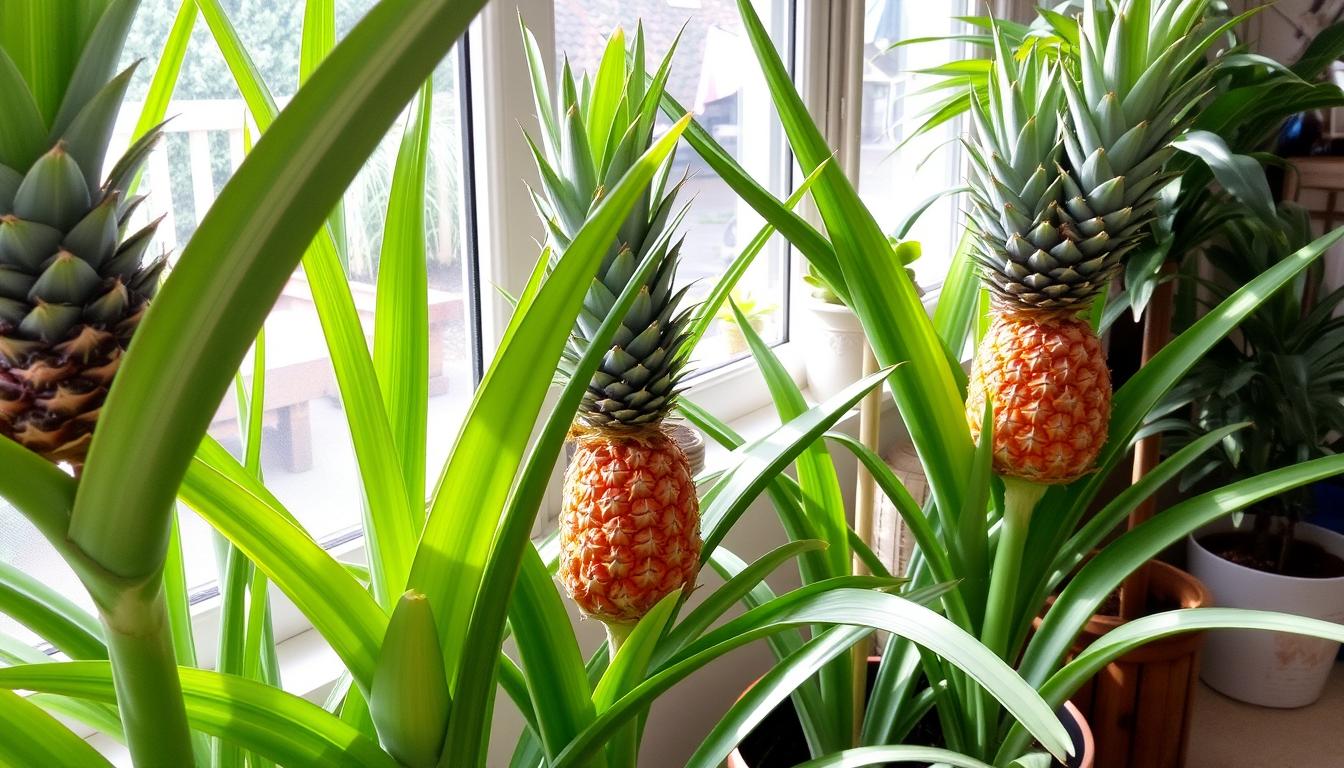Ever dreamed of having fresh pineapples from your home? Growing pineapples indoors is a real possibility. These plants, known as Ananas comosus, can grow well in your home. It’s a fun project for anyone who loves gardening.
But, it takes time. It can take two to three years for a pineapple to grow. Yet, the joy of picking your own fruit makes it all worth it.
To grow pineapples indoors, you need the right space, light, and care. As a beginner, following the right steps can lead to success. Growing pineapples indoors can be a rewarding experience. For more tips, check out this helpful resource for beginners.
Key Takeaways
- Pineapples take about 970 to 1400 days to harvest.
- Indoor pineapples require full sun and lots of light.
- They thrive in well-drained sandy loam soil with a pH of 4.5 to 6.5.
- Watering them consistently with at least 1 inch of water per week is essential.
- Regular fertilization every two months boosts growth and fruiting.
- Monitor for common pests like mealybugs to ensure plant health.
- Harvest your pineapple when it turns golden yellow and has a sweet aroma.
Introduction to Indoor Pineapple Cultivation
Growing pineapple at home is a fun and rewarding project. It combines beauty with the joy of growing your own food. Indoor gardening lets me have a tropical plant that brightens my space and gives me fresh fruits.
Starting with a pineapple plant makes me feel proud. Seeing it grow slowly but steadily turns it into a stunning centerpiece. Pineapples are tough and can grow in many conditions, making them a great choice for beginners.
Pineapples are easy to grow, and their roots adapt quickly. With a healthy pineapple top, growing one becomes a fun hobby. The chance to eat fresh pineapples from your kitchen is a big plus. This makes growing pineapples indoors a great choice for anyone wanting to improve their gardening skills.
Choosing the Right Pineapple for Growing Indoors
Choosing the right pineapple is key for growing indoors. A healthy pineapple makes a great starter plant. Look for signs of health and quality to ensure success.
Identifying a Healthy Pineapple
Finding a healthy pineapple is easy if you know what to look for. It should have a green crown and smell nice. The skin should be firm, without soft spots or color changes.
A ripe pineapple feels firm and tastes sweet. This means it’s ready to grow indoors.
Popular Varieties for Indoor Growing
Many pineapple varieties are great for indoor growing. The Smooth Cayenne is known for its sweet taste and grows well in containers. It’s perfect for indoor spaces.
Other varieties like Queen and Red Spanish also do well indoors. The right variety can make a big difference in your gardening success.
Knowing what to look for in pineapple varieties improves your indoor gardening. For more on growing plants and privacy policies, check out this resource.
How to Plant a Pineapple Top
Planting a pineapple top needs careful steps, especially when cutting the crown. Using the right methods can help your plant thrive. I’ve found that trying different ways to grow pineapples indoors can really help.
Best Practices for Cutting and Drying the Crown
When I start, I pick a healthy pineapple. Then, I cut the crown about an inch below the leaves. Make sure the crown has leaves to help the plant grow.
After cutting, drying the crown for a week is key. This step stops rot and gets the plant ready to root.
Different Methods of Propagation
Once the crown is dry, there are many ways to root it. Each method has its own benefits. It’s important to pick one that fits your setup.
- Water Propagation: Put the crown in a glass of water. Make sure the base is in water and the leaves are out. Change the water every week to help roots grow.
- Vermiculite Method: This method is great for drainage. I bury the crown’s base in moist vermiculite and cover it with more.
- Potting Soil: If you want to plant directly, use a mix that drains well. Plant the crown in the soil and water gently until it’s settled.
The method you choose depends on what you like and your space. But remember, patience is key. Soon, you’ll see roots, and your pineapple will be ready to grow indoors.

Best Soil for Pineapple Plants
Knowing what soil is best for pineapples is key for their growth indoors. The right soil mix must drain well to avoid root rot. This is a big problem for these tropical plants. A good soil mix can help the plant grow faster and stay healthy.
Characteristics of Ideal Soil
The perfect soil for pineapples has certain traits. It must drain well to keep the plant healthy. Heavy, wet soils can harm the plant. Important things to think about include:
- pH Level: A pH between 4.5 and 6.5 is best for pineapples.
- Organic Matter: Adding compost or aged manure helps with nutrients.
- Texture: A light texture, like sandy loam, helps with drainage.
Recommended Soil Mixes and Alternatives
Making the best soil mix for pineapples involves mixing different parts. I like using cactus potting soil, peat moss, and perlite. This mix drains well but keeps enough moisture. Here are some good soil mix ideas:
| Mix Composition | Benefits |
|---|---|
| Cactus Soil + Perlite | Maximizes drainage and aeration. |
| Peat Moss + Sand | Retains moisture while allowing for drainage. |
| Compost + Pine Bark | Adds nutrients and improves soil structure. |
By picking and mixing these ingredients, I can make a soil that’s perfect for pineapples. This ensures they grow strong and produce lots of fruit.
Watering and Humidity Needs
To keep my indoor pineapple plants healthy, I focus on their watering needs. Watering them right is key, as they love moist soil but hate wet feet. I water when the top inch of soil feels dry. This keeps the soil just right for my pineapple’s growth.
Keeping the right humidity for indoor plants is also important. Pineapples do best in humid air, around 50% to 60%. If my home is too dry, I use a pebble tray under the pot. It boosts humidity and makes a cozy spot for my pineapple. I also mist the leaves a few times a week. But, too much water can cause mold, so be careful.
Here are some helpful watering tips for your pineapple plant:
- Water thoroughly, making sure water drains out of the pot’s holes.
- Don’t water directly into the plant’s center to avoid rot.
- Check the soil moisture often, especially when it’s hot.
Lighting Requirements for Optimal Growth
Proper lighting is key for indoor pineapple plants to thrive. Knowing the pineapple lighting needs helps ensure they get the right light. Pineapples need at least six to eight hours of bright light each day. This is important for their growth and to produce fruit.
Natural Light vs. Artificial Grow Lights
Natural sunlight is best for pineapples, but not everyone has enough sunlight. For those without enough light, grow lights for indoor plants are a good choice. LED grow lights are great because they help plants grow well and last a long time.
They work well because they give off the right kind of light for plants. Plus, they don’t get too hot, so you can put them close to your plants. With the right care, they can last up to a hundred thousand hours.
Best Placement in Your Home
Choosing the best locations for growing pineapples in your home is important. Look for south- or west-facing windows that get lots of light. If you don’t have enough natural light, use artificial lighting.
I suggest using T5 fluorescent lights or high-quality LED lights. These can help mimic natural sunlight and support your pineapple plants’ growth.

Pineapple Plant Care and Maintenance
Caring for pineapple plants needs special steps to keep them healthy and productive. Regular care, like proper fertilizing and fixing common problems, is key. This ensures your plants grow well and produce fruit.
Fertilizing Your Pineapple Plant
For the best growth, follow good fertilizing tips. Feed young plants with a weak liquid fertilizer every month when they’re growing. This gives them the nutrients they need for growth and fruit.
Choose fertilizers that are balanced and have enough potassium. Potassium helps keep the plant healthy.
Common Issues and Solutions
While growing pineapple plants, you might face some issues. Yellow leaves mean the plant might not have enough nutrients or is getting too much water. Check your watering and fertilizing to fix this.
Also, pests can harm your plants. Watch your plants closely to catch problems early. Keeping your growing area clean and using insecticidal soap can help fight pests.
For more tips on keeping your plants healthy, check out this guide. It talks about caring for plants in different conditions.
How to Grow Strawberries at Home: Complete Guide
Growing strawberries indoors is rewarding and brings fresh fruits to your kitchen. Home strawberry gardening is fun and fulfilling. This guide covers key strawberry cultivation aspects, like ideal conditions, care, and planting tips.
I start with Albion strawberry plants for their sweet taste and disease resistance. I space them 14-18 inches apart for each plant to grow well. For a daily harvest, about 25 plants are needed.
Fertilizing is key in strawberry care. I fertilize June and spring bearing strawberries twice a year. Everbearing strawberries get fed every two weeks. The soil pH should be 5.5 to 6.5 for best growth.
Sunlight is crucial for my strawberry plants. They need at least 6-8 hours of direct sunlight daily. When planting strawberries with tomatoes, peppers, or eggplants, wait at least 3 years to avoid diseases.
| Aspect | Details |
|---|---|
| Plant Type | Albion Strawberry |
| Plant Spacing | 14-18 inches apart |
| Plants for Daily Yield | 25 plants |
| Fertilization Frequency (June/Spring Bearing) | Twice a year |
| Fertilization Frequency (Everbearing) | Every two weeks |
| Soil pH | 5.5 – 6.5 |
| Sunlight Requirement | 6-8 hours daily |
| Time before Replanting in Previously Used Beds | 3 years |
| Time to Harvest after Planting | 2 days |
By following these tips, my indoor strawberry growing is fruitful and fun. I encourage others to try these methods for great results at home.
Harvesting Your Homegrown Pineapples
Harvesting pineapple is exciting for indoor gardeners. Knowing when to pick it makes it even better. Pineapples take 18 to 24 months to ripen after flowering. Picking them at the right time ensures they taste sweet and flavorful.
Look for signs of ripeness in your pineapple. A ripe one will have a bright yellow color, especially at the base. Also, check if it’s firm but slightly soft to the touch.
Using indoor fruit harvesting tips can help. Twist the pineapple gently to see if it comes off easily. If it does, it’s ready. You’ll also know it’s ripe when it smells sweet and fragrant.
It’s important to harvest pineapples correctly. Cut them close to the base with a sharp knife. This helps the plant grow more. Enjoying your homegrown pineapples at their sweetest is rewarding.
| Signs of Ripeness | Tips for Harvesting |
|---|---|
| Bright yellow color at the base | Use a sharp knife for cutting |
| Fruits yield slightly to pressure | Twist the fruit to check for ease of separation |
| Sweet aroma from the fruit | Harvest during the day for peak sweetness |
Bringing Pineapples Outdoors in Warm Months
Moving pineapple plants outside in warm months has many benefits. It can greatly improve their growth and fruit production. It’s important to plan carefully, especially when moving indoor plants outside.
Start by gradually introducing them to outdoor conditions. This helps prevent shock and makes the transition smoother.
Begin with a few hours of indirect sunlight and then increase to full sun. This helps the plant grow strong and adapt to outdoor light. It’s also key to learn about pineapple summer care.
This includes watching how the plant reacts to more sunlight. You might need to adjust how often you water to avoid drying out.
When moving plants, keep an eye out for pests that love the outdoors. Regular checks can catch problems early. This lets you take action quickly to keep your plants healthy.
Watering and keeping humidity levels right are also crucial during this time. This ensures your plants stay healthy and thrive in their new spot.
Bringing pineapple plants outside can make them healthier and more fruitful. With careful acclimation and proper care, this move can be a big win for indoor gardeners.
Conclusion
Growing pineapples indoors can be very rewarding. It starts with picking the right variety and knowing how to care for it. Each step is important for your pineapple to grow well.
By following the tips we’ve shared, you can grow your own pineapple. It takes patience and dedication, but it’s worth it.
When growing pineapples, it’s key to watch their health and adjust their care as needed. Every plant is different, so pay attention to your pineapple’s needs. If you have questions, you can find help on our contact page.
Home gardening is more than just growing plants. It’s a way to connect with nature. Start growing your own indoor pineapple today. The joy of watching it grow is amazing.



Leave a Reply